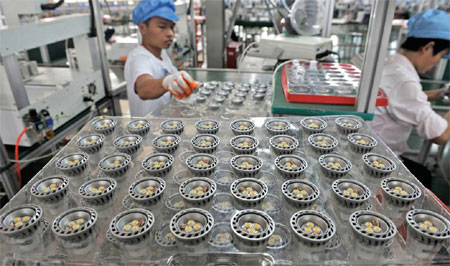Pushing the reset button
By Meng Jing (China Daily) Updated: 2012-09-15 15:32Small LED lighting producers in China are banding together to take on the industry's multinational giants in the West
The invention of incandescent lamps by American inventor Thomas Edison more than a century ago not only marked the beginning of the modern lighting industry, but also the birth of pioneering conglomerate General Electric. Today, the global wave of phasing out incandescent lamps is doing the same trick.
With the dawn of energy efficiency, many international companies are trying to catch that spark that will push them ahead in the industry, not least of all companies in China.
|
 LED lighting technology is believed to be the next big thing and the main battleground between multinational and Chinese players in the lighting industry. [Photo/China Daily] |
But if there was ever a time for a Chinese lighting company to make a breakthrough, that time is now.
On Oct 1, China, the world's largest lighting market, is hitting the reset button with its ban on the sales of incandescent lamps. The upcoming move, in addition to the Chinese government's desire to increase efficiency, cut down its carbon intensity and manufacture more LED (light emitting diode) products, is set to slowly but significantly change the nation's lighting market.
"The possibility of the reset of the new world order in lighting lies in two simple facts. One is the potentially huge LED lighting market in China, the other is the Chinese government's strong desire to build LED lighting into a strategic new industry," says Wang Fei, a Shenzhen-based analyst with LEDinside, a unit under the consulting firm TrendForce. "The combined home advantage can help Chinese producers to be among the world's top 10 lighting producers in 10 years."
Both LED lighting reports released in 2011 by HSBC Climate Change, HSBC's global research subsidiary, and the global consultancy McKinsey identify China as the most important market for LED lighting. Both say China's massive population, rapid urbanization, rising incomes and economic development create the most growth potential in the LED market worldwide.
According to McKinsey, the size of China's overall lighting market is projected to grow twice as fast as the global average, reaching 13 billion euros ($16.79 billion) by 2016 (or 17 percent of the global market), with its LED lighting market reaching 11 billion euros by 2020 (accounting for 20 percent of the world's total revenues).
Philips, the leading lighting producer based in the Netherlands, expects LED lighting products to account for 50 percent of the general lighting market in China by 2015.
"We don't think LED lighting can completely replace conventional lighting products. But the vast lighting market will still make China the largest market in the world for LED in the years to come," says Tommy Leong, president of Philips Lighting Great China.
LED lighting products, which are powered by semiconductors, are a vast improvement on conventional lighting products in many ways. They are not only more energy efficient, have a longer life span and are environmentally safer. LED lighting is very different from traditional technologies that use electrical filaments or plasma with bulky glass covers.
On the other hand, LED products are pricey to produce and purchase, which is why China has been slow to adopt the technology. The alternative to LED products - compact fluorescent lamps - is much cheaper, but not as environmentally safe nor as widely available.
The good news is that prices for LED products are dropping at a clip of about 20 to 30 percent a year. That bodes well for China, Leong says, because apart from the central government's resolve to cut down on its energy footprint, the government is eager to build the LED lighting industry into another driving force for its growing economy.
In July, the nation released the first national Five-Year Plan (2011-15) for the semiconductor lighting industry, setting a plan to boost the industry into a 500-billion-yuan ($79 billion) sector with at least 20 to 30 leading domestic companies by 2015.
But China's vision for the LED lighting industry was actually molded three years earlier. In 2009, the central government chose around 20 pilot cities to replace their conventional street lamps with LED lighting, cutting hefty checks to LED lighting suppliers, the majority of which were domestic producers.
The number of cities to receive LED lighting is set to rise to 50 by 2015. Incentives are also coming from the provincial level: South China's Guangdong province announced earlier this year that it will replace all public lighting with LEDs within three years, aiming to boost the size of its local LED lighting industry from 100 billion yuan in 2011 to 500 billion yuan in 2015.
As China's promising LED market grows, investors from multinational lighting giants have been drawn to the fire. Both Germany-based Osram AG, a multinational lighting manufacturer, and Dutch electronics conglomerate Philips have pumped millions of euros to build up local production chains this year. But the two will be competing against thousands of smaller Chinese investors expanding production capacity, creating what insiders are say is an oversupplied market.
Casualties are already piling up because of the flooded market. A number of Chinese LED producers have filed for bankruptcies and many companies that make LED lighting products are reporting a drop in sales.
- China's coal-producing province to reform electricity pricing
- China to play unifier, innovator role with 'Belt and Road'
- First electricity trading centers open in Beijing and Guangzhou
- Mainland entrepreneurs sparking boom in startups
- Chinese manufacturing hub on front lines of robot revolution
- More pro-growth policies expected for China's economy
- RRR cut boosts property stocks
- Wenzhou whizzes take it easy in realty market
















